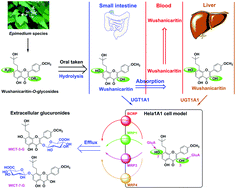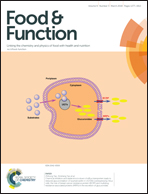Chemical inhibition and stable knock-down of efflux transporters leads to reduced glucuronidation of wushanicaritin in UGT1A1-overexpressing HeLa cells: the role of breast cancer resistance protein (BCRP) and multidrug resistance-associated proteins (MRPs) in the excretion of glucuronides†
Abstract
Active efflux transport of glucuronides out of cells is a critical process in elimination of drugs and food-derived compounds. Wushanicaritin, a natural polyphenol from Epimedium species, has shown many biological activities. However, the transporters responsible for excretion of wushanicaritin glucuronides still remain undefined. Herein, chemical inhibitors (Ko143, MK571, dipyridamole and leukotriene C4) and single stable knocked-down efflux transporters (BCRP, MRP1, MRP3 and MRP4) were used to determine the contributions of efflux transporters to glucuronide efflux and cellular glucuronidation in UGT1A1-overexpressing HeLa cells (HeLa1A1). Knock-down of transporters was performed by stable transfection of short hairpin RNA (shRNA) using lentiviral vectors. The HeLa1A1 cell lysate catalyzed wushanicaritin glucuronidation, generating wushanicaritin-3-O-glucuronide and wushanicaritin-7-O-glucuronide. Ko143 (a dual inhibitor of BCRP, 5–20 μM) caused a marked decrease in excretion rate (maximal 53.4%) and increase of intracellular glucuronides (maximal 86.0%), while MK-571 (an inhibitor of MRPs, 5–20 μM) resulted in a significant reduction in excretion rate (maximal 64.6%) and rise of intracellular glucuronides (maximal 98.0%). By contrast, dipyridamole and leukotriene C4 showed no inhibitory effects on glucuronide excretion. Furthermore, shRNA-mediated silencing of a target transporter led to a marked reduction in the excretion rate of wushanicaritin glucuronides (maximal 33.8% for BCRP; 25.9% for MRP1; 26.7% for MRP3; 39.3% for MRP4). Transporter silencing also led to substantial decreases in efflux clearance (maximal 61.5% for BCRP; 48.7% for MRP1; 35.1% for MRP3; 63.1% for MRP4). In conclusion, chemical inhibition and gene silencing results suggested that BCRP, MRP1, MRP3 and MRP4 were significant contributors to excretion of wushanicaritin glucuronides.



 Please wait while we load your content...
Please wait while we load your content...